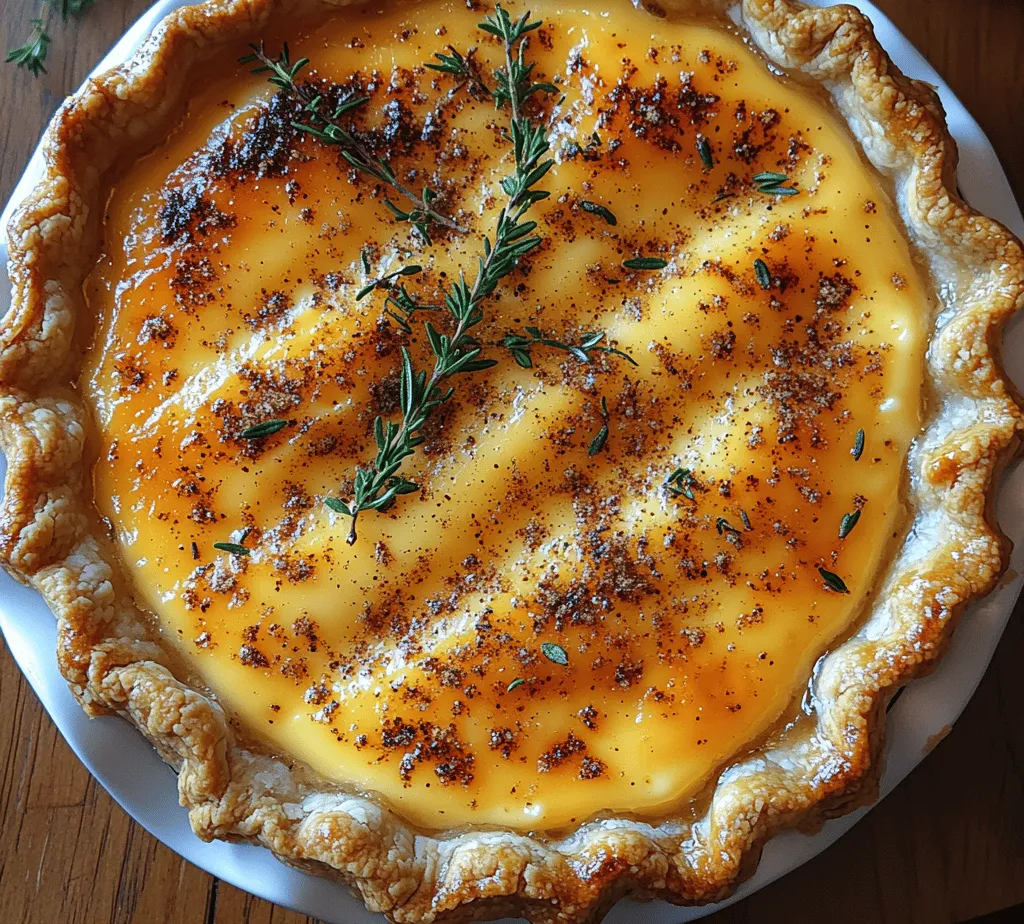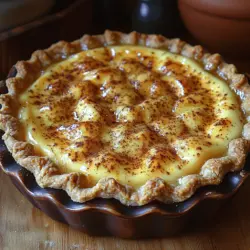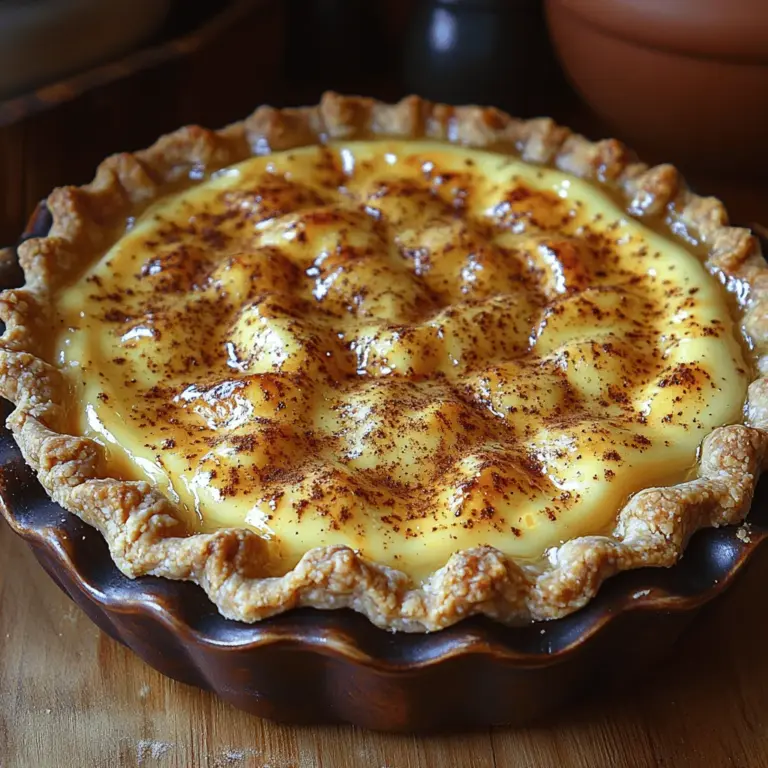Introduction to Classic Comfort Egg Custard Pie
Egg custard pie is a beloved dessert that has graced dining tables for generations, evoking feelings of warmth and nostalgia. This classic comfort food, characterized by its creamy texture and delicate balance of sweetness and spice, is a staple in many households. The simple yet indulgent nature of egg custard pie makes it a go-to treat for family gatherings, holiday celebrations, and everyday indulgences alike.
As we explore the history of egg custard pie, you’ll discover its evolution through various cultures and cuisines, revealing why it has maintained its status as a cherished dessert. More than just a recipe, the egg custard pie is a symbol of home-cooked warmth and love, often tied to cherished memories of family and tradition.
In this article, we will provide a comprehensive recipe that you can easily follow at home. Whether you are new to baking or an experienced home cook, you’ll find that making an egg custard pie is both simple and rewarding. Let’s uncover the secrets to creating a perfect egg custard pie that will delight your family and friends.
Understanding Egg Custard Pie
A Brief History of Egg Custard Pie
Egg custard pie has a rich and storied history that dates back to the medieval period. Its origins can be traced to early English recipes, where custard was often served in pie form, showcasing the versatility of the custard filling. The concept of custard itself is believed to have emerged in the 14th century, evolving as ingredients became more accessible and culinary techniques advanced.
As settlers from Europe arrived in America, they brought their culinary traditions with them, including the beloved egg custard pie. Over the years, the pie has undergone various adaptations, with regional variations emerging across the United States. In the South, for instance, the egg custard pie became a staple dessert, often served at family gatherings and church potlucks.
Today, egg custard pie remains a testament to the timeless appeal of simple, wholesome ingredients. It reflects the desire for comfort food that transcends generations, bringing families together over shared recipes and fond memories.
Why Egg Custard Pie is a Comfort Food
The emotional connection people have with egg custard pie is profound. For many, it represents more than just a dessert; it symbolizes love, tradition, and the comfort of home. The familiar aroma of nutmeg and vanilla wafting from the oven can transport individuals back to their childhood, evoking memories of family gatherings and celebrations.
Egg custard pie often finds its place at the center of important life events—be it holidays, birthdays, or Sunday dinners. The act of baking this pie can also be a therapeutic experience, allowing individuals to engage in a mindful activity that results in a delicious reward.
Moreover, the creamy texture and gentle sweetness of the custard filling provide a sense of indulgence without overwhelming the palate. This balance makes egg custard pie an ideal dessert for all occasions, whether enjoyed on its own or paired with a dollop of whipped cream or fresh fruit.
Ingredients for Classic Egg Custard Pie
For those eager to recreate this delightful dessert, understanding the ingredients is essential. Each component plays a crucial role in achieving the perfect flavor and texture of the egg custard pie.
The Pie Crust
The first decision to make when preparing an egg custard pie is whether to use a homemade or store-bought pie crust.
– Homemade Crust: Making your own pie crust from scratch allows for a customizable experience where you can control the ingredients, texture, and flavor. A basic pie crust typically consists of flour, butter, salt, and cold water. It can be a rewarding endeavor, especially when you see the golden, flaky crust emerge from the oven.
– Store-Bought Crust: For those short on time or looking for convenience, store-bought crusts are a viable option. They come pre-formed and ready to bake, saving you significant preparation time. However, it’s important to choose a high-quality crust to ensure a delicious final result.
Both options have their pros and cons, and the choice ultimately depends on your preferences and available time.
Key Ingredients for the Custard Filling
The custard filling is the heart of the egg custard pie, and understanding the role of each ingredient will help you achieve the best results. The primary ingredients include:
– Eggs: The foundation of the custard, eggs provide structure and richness. They also contribute to the creamy texture that is characteristic of a great custard pie.
– Sugar: Sweetness is essential in balancing the flavors of the pie. Granulated sugar is commonly used, but you can experiment with alternatives like brown sugar for a deeper flavor.
– Milk: Whole milk is typically used for a richer custard, but you can substitute with half-and-half or cream for an even creamier texture.
– Vanilla Extract: This ingredient adds a layer of flavor that complements the custard beautifully. Using pure vanilla extract is recommended for the best taste.
– Salt: A pinch of salt enhances the overall flavor of the pie, balancing the sweetness.
– Nutmeg: This spice is a traditional addition to egg custard pie, lending a warm, aromatic note that defines its flavor profile. Freshly grated nutmeg is recommended for the best results.
Optional Additions
While the classic egg custard pie recipe is delightful on its own, you can enhance its flavor with optional additions:
– Butter: Adding melted butter to the custard mixture can enrich the flavor and provide a silky texture. This is an excellent option for those who enjoy a more decadent pie.
– Spice Variations: While nutmeg is a staple, consider experimenting with other spices such as cinnamon or cardamom for a unique twist on the classic recipe.
Step-by-Step Instructions for Making Egg Custard Pie
Now that you understand the ingredients and their significance, it’s time to dive into the step-by-step instructions for making a classic egg custard pie. The process is straightforward and broken down into manageable steps:
Preheating the Oven
Before you start mixing ingredients, it’s crucial to preheat your oven. Preheating ensures that your pie bakes evenly, leading to a perfectly set custard and a beautifully golden crust. Set your oven to 350°F (175°C) and allow it to reach the desired temperature while you prepare the pie filling and crust.
This initial step is often overlooked, but it plays a significant role in baking success. A properly preheated oven provides a consistent temperature, allowing the custard to cook through without curdling and the crust to brown beautifully.
By following these guidelines, you’ll be well on your way to creating a classic egg custard pie that not only tastes fantastic but also embodies the warmth and comfort of home baking. Stay tuned for the next sections, where we will dive deeper into the preparation and baking process, ensuring that your pie turns out perfectly every time.

Preparing the Pie Crust
The foundation of a great egg custard pie is a deliciously flaky crust. You have the option to create a homemade pie crust or use a store-bought one, depending on your time constraints and preference.
Homemade Pie Crust
Ingredients:
– 1 ¼ cups all-purpose flour
– ½ teaspoon salt
– 1 tablespoon sugar
– ½ cup unsalted butter, chilled and diced
– 4–5 tablespoons ice water
Instructions:
1. Mix Dry Ingredients: In a large mixing bowl, combine the flour, salt, and sugar. Whisk them together until evenly distributed.
2. Cut in Butter: Add the chilled, diced butter to the flour mixture. Using a pastry cutter or your fingers, cut the butter into the flour until the mixture resembles coarse crumbs with pea-sized butter pieces.
3. Add Ice Water: Gradually add the ice water, one tablespoon at a time, mixing with a fork until the dough comes together. You may not need all the water, so stop adding it once the dough holds together without being sticky.
4. Chill the Dough: Form the dough into a disk, wrap it in plastic wrap, and refrigerate for at least 1 hour. This helps to relax the gluten, making the crust tender.
5. Roll Out the Dough: After chilling, roll the dough out on a lightly floured surface to fit your pie pan. Aim for about 1/8-inch thickness.
6. Fit into Pie Pan: Carefully transfer the rolled-out dough into your pie pan, pressing it gently into the sides. Trim any excess dough hanging over the edges and crimp the edges for a decorative finish.
7. Prevent Bubbling: To prevent bubbling while baking, prick the bottom of the crust with a fork (this is known as docking) and place parchment paper over the crust, filling it with pie weights or dried beans. This will keep the crust flat while baking.
8. Pre-bake the Crust: Preheat your oven to 425°F (220°C). Bake the crust for about 10-12 minutes, or until lightly golden. Remove from the oven and let it cool slightly while you prepare the custard filling.
Store-bought Pie Crust
If you’re short on time, a store-bought pie crust can be a great alternative. Follow these steps for a successful pre-baked crust:
1. Prepare the Crust: Remove the crust from the packaging and fit it into your pie pan as directed.
2. Dock and Pre-bake: Just like with a homemade crust, dock the bottom of the crust with a fork, place parchment paper inside, and fill with weights. Pre-bake according to package instructions, usually at 425°F (220°C) for 10-12 minutes, until golden.
Mixing the Custard Filling
The custard filling is the heart of egg custard pie, and achieving the right consistency is crucial for a smooth and creamy texture.
Ingredients:
– 4 large eggs
– 1 cup granulated sugar
– ¼ teaspoon salt
– 2 cups whole milk
– 1 teaspoon vanilla extract
– 1 tablespoon unsalted butter, melted (optional)
Instructions:
1. Whisk Together Eggs and Sugar: In a large mixing bowl, crack the eggs and add the granulated sugar and salt. Using a whisk, beat the mixture until it becomes pale and slightly frothy. This helps to incorporate air, which is essential for a light custard.
2. Add Milk and Flavorings: Gradually pour in the whole milk while continuing to whisk. Add the vanilla extract, mixing until everything is well combined. If you choose to add melted butter for richness, do so at this stage, ensuring it cools slightly before adding to prevent cooking the eggs.
3. Strain the Mixture: For an ultra-smooth custard, strain the mixture through a fine-mesh sieve into a large measuring cup or bowl. This step removes any chalazae or egg bits, resulting in a silky custard filling.
Combining and Pouring
Now that you have both your crust and custard filling ready, it’s time to combine them with care.
1. Prepare for Pouring: Make sure your pre-baked pie crust is slightly cooled but still warm. This helps the custard set evenly.
2. Pour the Custard: Place the pie pan on a baking sheet (this makes it easier to transfer to and from the oven). Carefully pour the custard mixture into the crust, filling it up to the edge without overfilling to avoid spills.
3. Prevent Spills: To prevent any potential sloshing or spills while transferring to the oven, place a baking sheet under the pie pan before pouring the custard. This ensures any drips are caught without making a mess.
Baking the Pie
Baking the pie is where the magic happens, transforming the liquid custard into a smooth, creamy filling.
1. Preheat Your Oven: Ensure your oven is preheated to 350°F (175°C) before placing the pie inside.
2. Bake the Pie: Place the pie in the oven and bake for approximately 45-55 minutes. The custard is done when the edges are set, but the center still has a slight jiggle. To check for doneness, gently shake the pie; the center should slightly wobble but should not appear liquid.
3. Cool the Pie: Once baked, remove the pie from the oven and allow it to cool on a wire rack for at least 1 hour. The custard will continue to set as it cools.
Cooling and Serving
For the best texture and flavor, proper cooling is essential before serving.
1. Refrigerate the Pie: After cooling at room temperature, cover the pie with plastic wrap or foil and refrigerate for at least 2 hours, or overnight if possible. This chilling time allows the custard to firm up and enhances the overall flavor.
2. Serving the Pie: When ready to serve, slice the pie into wedges using a sharp knife. For the cleanest cuts, wipe the knife with a damp cloth between slices.
Serving Suggestions and Pairings
Egg custard pie is delightful on its own, but a few thoughtful touches can elevate the experience.
Garnishing with Nutmeg
Sprinkling freshly grated nutmeg over the top of your custard pie not only adds a touch of visual appeal but also enhances the flavor profile with its warm, spicy notes. Use a microplane to grate a small amount right before serving for the best aroma.
Pairing with Beverages
To complement the richness of the custard pie, consider pairing it with beverages such as:
– Coffee: A warm cup of coffee, whether brewed or espresso, balances the sweetness and creaminess of the pie beautifully.
– Tea: A light herbal tea or a classic Earl Grey can provide a refreshing contrast.
– Dessert Wine: A glass of sweet dessert wine, such as a late harvest Riesling or a Sauternes, can enhance the indulgence of your dessert.
Nutritional Information
Understanding the nutritional components of your egg custard pie can help you enjoy it mindfully.
– Serving Size: 1 slice (1/8 of the pie)
– Calories: Approximately 250-300 calories per slice (this can vary based on specific ingredients used)
– Total Fat: 15g (saturated fat: 8g)
– Cholesterol: 100mg
– Sodium: 150mg
– Total Carbohydrates: 30g (sugars: 20g)
– Protein: 5g
This breakdown highlights the richness of this dessert, making it a treat best enjoyed in moderation.
Conclusion: The Timeless Appeal of Egg Custard Pie
Egg custard pie embodies the essence of comfort food, capturing the hearts of many with its creamy texture and sweet, delicate flavor. Its simplicity in preparation allows both novice and seasoned bakers to create this classic dessert with ease. Whether served at holiday gatherings, family dinners, or simply as a sweet treat on a quiet evening, egg custard pie warms the soul and brings a sense of nostalgia.
The next time you find yourself craving a sweet indulgence, remember the joy of making and sharing this beloved classic. Rediscover the timeless charm of egg custard pie, and let it fill your home with delightful aromas and happy moments that linger long after the last slice is served.

